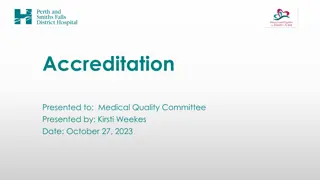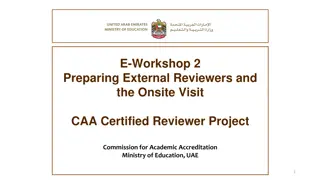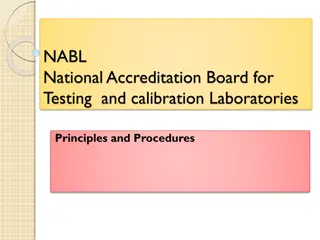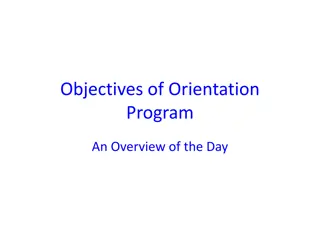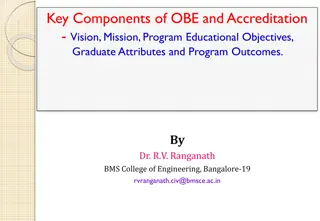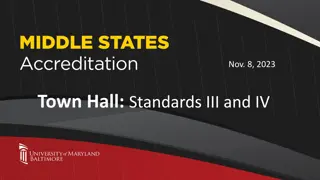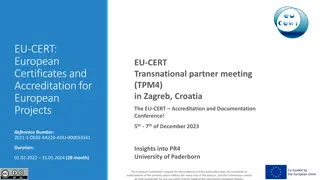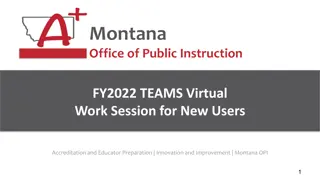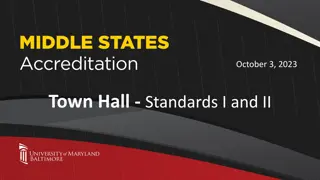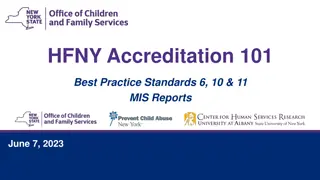Evolution of University Program Reviews in Higher Education Accreditation
Reviewer Training for Higher Education Accreditations discusses the history and evolution of university program reviews, highlighting the transition from AER approval to accreditation, establishment of accreditation councils, and the role of review panels in evaluating programs. The organizational structure of AER and AERAC is detailed, emphasizing the importance of independent decision-making. Accredited programs can be found on the AER website, and the composition and responsibilities of the AER Accreditation Council are outlined.
Download Presentation

Please find below an Image/Link to download the presentation.
The content on the website is provided AS IS for your information and personal use only. It may not be sold, licensed, or shared on other websites without obtaining consent from the author. Download presentation by click this link. If you encounter any issues during the download, it is possible that the publisher has removed the file from their server.
E N D
Presentation Transcript
Reviewer Training for Higher Education Accreditations
HISTORY OF UNIVERSITY PROGRAM REVIEWS * AER Divisions separately reviewed University Programs in the 1970 s * In the early 2000 s program reviews were erratic * In 2009-2010, Programs review was consolidated under an interdivisional approach supported by AER Board rather than though the individual divisions o Review was made electronic o Standards were revised o New structure was developed
HISTORY, continued In 2016 the AER Board approved a plan to move from AER approval to AER accreditation of university programs. In 2017 the AER Board adopted the National Accreditation Council which reviewed agencies and schools for the blind. Independent Accreditation Council established o Accreditation Council incorporated AER s existing university program accreditation and established Higher Education Accreditation Commission (HEAC) o Goal established to pursue recognition by Council for Higher Education Accreditation (CHEA)
Organization of AER and AERAC The chart on the next slide shows two separate structures: the AER Board and membership structure; and an independent AER Accreditation Council structure. It is important for the AER Accreditation Council to make independent decisions from the AER board so that the Council has the authority it needs and the legitimacy that is required. AER Central Office coordinates the work of the Council, the Higher Education Accreditation Commission and the Review Panels. HEAC develops the standards, the review panels use the standards to evaluate the programs and report back to HEAC. The Accreditation Council approves the recommendation for accreditation status, adjudicates appeals and follows up on provisional accreditation and annual reports.
AER ORGANIZATIONAL CHART AERBVI BOARD OF DIRECTORS EXECUTIVE COMMITTEE The illustration on the right shows the two separate structures within AERBVI as explained on the previous slide. MEMBERSHIP AER ACCREDITATION COUNCIL (AERAC) HEAC = higher educ programs OSAC = orgs + schools Review Panels Review Panels
WEBSITE TIP Accredited programs are listed on the AER Website: https://aerbvi.org/accreditation/
ROLE AND COMPOSITION OF THE AER Accreditation Council (AERAC) POLICY AND STANDARDS APPROVAL MAKES ALL ACCREDITATION DECISIONS CHAIR IS AER EXECUTIVE DIRECTOR MEMBERS (UP TO 12) o Representatives of Consumer Organizations, and Field Related Professionals/Experts, o Chair of Higher Education Accreditation Commission o Chair of Organizations and Schools Accreditation Commission o Member representing the public
ROLES OF THE Higher Education Accreditation Commission (HEAC) POLICY AND STANDARDS DEVELOPMENT SELECTION OF REVIEW PANELS PANEL RECOMMENDATIONS REVIEW
COMPOSITION OF THE Higher Education Accreditation Commission(HEAC) MEMBERS o Chair who also serves as a member of AER Accreditation Council o Low Vision Therapist o Orientation and Mobility Specialist o Vision Rehabilitation Therapist o Assistive Technology Specialist o Teacher of Students with Visual Impairment o Member at Large
Reviewer Qualifications Accreditation Review Panels a) Three or more years of recent (i.e., within the last 5 years) related field and/or administrative experience or at least 10 years of prior related experiences. b) No conflict of interest with the organization or higher education institution seeking accreditation. c) Completion of a self-directed course using materials provided by AERAC and passing of an exam with a score of 80 or better. d) Excellent oral and written communication skills.
Composition of Accreditation Review Panels HEAC review panels have 4 members: 1 faculty member 2 discipline-specific members 1 associated discipline member
Role of Accreditation Review Panels The Core materials provided by the program seeking accreditation are reviewed by the full panel. The Curricular materials are divided between two groups of 2 panel members each. The panel chooses which members will interview which key constituents, faculty and administration. The full panel prepares a report on their findings and recommendation. The AER Accreditation Manager conveys it to HEAC.
Ethical Considerations for Accreditation Review Panels It goes without saying, but we ll say it anyway: Reviewers have an ethical obligation to review programs objectively and to render their decision based on the information gathered in the review process. Any personal or professional opinions outside the review process should not affect the panel's decisions, although observations about the review process and/or the standards themselves are welcome.
Higher Education Review Process, Part 1 1. The program submits the application form linked on the website and the processing fee* to AER. Applications are accepted at any time throughout the year. 2. The program completes a self-study rating of each CORE and CURRICULAR standard and submits on-line to AER. 3. A review panel is appointed by HEAC and confirmed as having no conflicts of interest by the University. 4. An initial zoom conference call for the panel is facilitated by the AER Accreditation Manager to divide up the panel tasks.
*Processing Fee $1750 is required fee to cover costs of the accreditation process. Discounts apply for universities with more than one program to review who pay the fees for all at the same time (even if the reviews of the additional programs are not done all at the same time): Second Program $1500 Third Program $1250
Classification of Standards NOTE: All standards can be seen at https://aerbvi.org/higher-education-colleges-and- universities- There are 2 sets of standards: CORE STANDARDS CURRICULAR STANDARDS
CORE STANDARDS CORE standards are administrative in nature. All core standards must be fully met for an institution to be accredited.
CURRICULAR STANDARDS CURRICULAR standards pertain to the specific course of study: O&M, VRT, LVT, AT, or TSVI. All curricular standards must be fully met for an institution to be fully accredited.
Higher Education Review Process, Part 2 Each member of the review panel studies the materials provided by the university and makes their individual determination of compliance with CORE and CURRICULAR standards. 1. The Accreditation Manager facilitates Zoom conferences for the panel to come to consensus on scoring of each standard. If needed, requests for additional information are sent to the university program. 2. The review panel conducts telephone interviews with program leadership and students and makes a virtual site visit (Zoom). 3. The panel discusses the compiled data and makes a report/recommendation. Report is shared with University for 2 weeks for factual review. Final Report is submitted to the Higher Education Accreditation Commission (HEAC). 4.
Steps in University Review Process Part 3 HEAC confirms all standards are met and makes a status recommendation. Chair of HEAC presents recommendation to the AER Accreditation Council for a final decision. If there are no unforeseen delays after the university program submits all required materials, the whole process results in a decision in approximately 120 days.
Four Accreditation Status Levels Full Accreditation: the university program has fully met all Core and all Curricular standards. 1. * Granted for Five Years.
Accreditation Status: PROVISIONAL 2. Provisional Accreditation: granted to candidates seeking initial accreditation, for a period of one year. Provisional accreditation is awarded when the program has demonstrated substantial progress towards meeting all the standards but needs additional time to come into full compliance. Program must commit in writing to meeting all Core and Curricular standards within one year. The program is not accredited at this time.
Accreditation Status: PROBATIONARY 3. Probationary Accreditation: granted for one year for candidates applying for reaccreditation. Probationary accreditation is awarded when the program is making substantial progress towards meeting all of the standards but needs additional time to come into full compliance. Program must commit in writing to meeting all Core and Curricular standards within one year. The program remains accredited at this time.
Accreditation Status: DENIED 4. Accreditation Denial is determined if the outcome of the review process shows that the program is not in substantial compliance with the standards. An appeals process is clearly outlined in the AERAC Policies Manual: https://aerbvi.org//accreditation
APPEALS In situations where the university disputes the decision of the AER Accreditation Council, an appeal can be filed with the AER Central Office: accreditation@aerbvi.org. Policies and Procedures Manual linked on the Full details can be found in the AER Accreditation Council website: https://aerbvi.org/ accreditation AERAC will hear the case and then make a final determination by appointing an independent committee to review all materials.
ANNUAL UPDATE FORM An accreditation is valid for 5 years and requires that the program submit an annual update report for a calendar year, due the following March 31. Accreditation can be revoked at the discretion of the Council if the program does not submit an annual update report and/or fails to demonstrate a continuous adherence to the standards. A Sample can be found here: aerbvi.org/highere-education- colleges-and-universities-
QUESTIONS? FEEL FREE TO EMAIL ACCREDITATION@AERBVI.ORG TO ARRANGE A CALL OR ZOOM MEETING.



